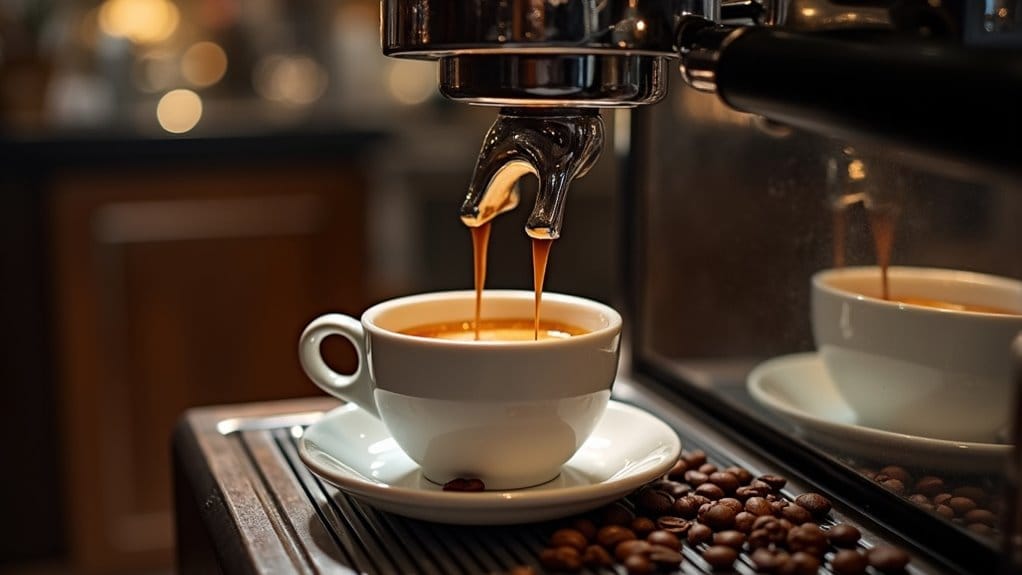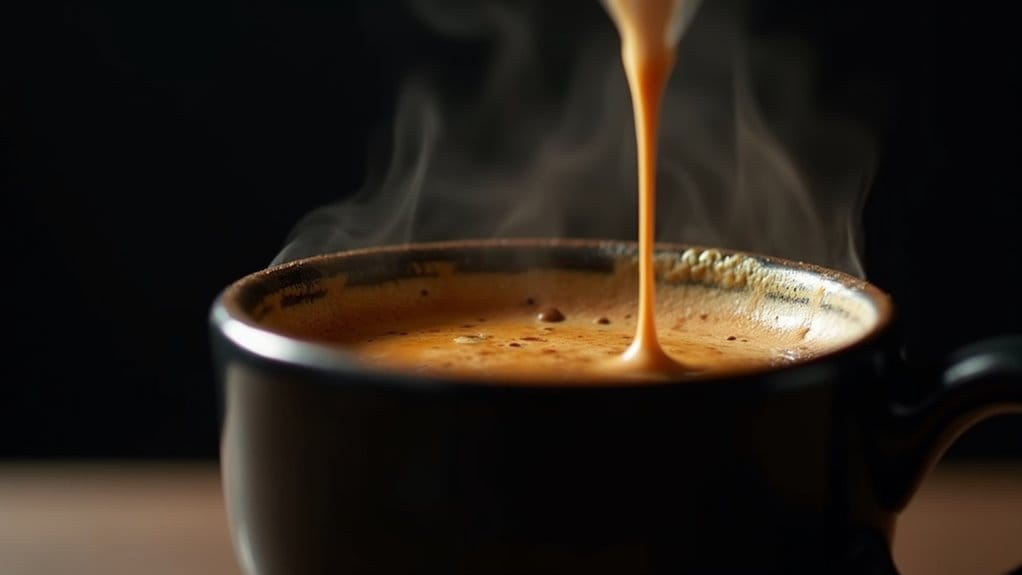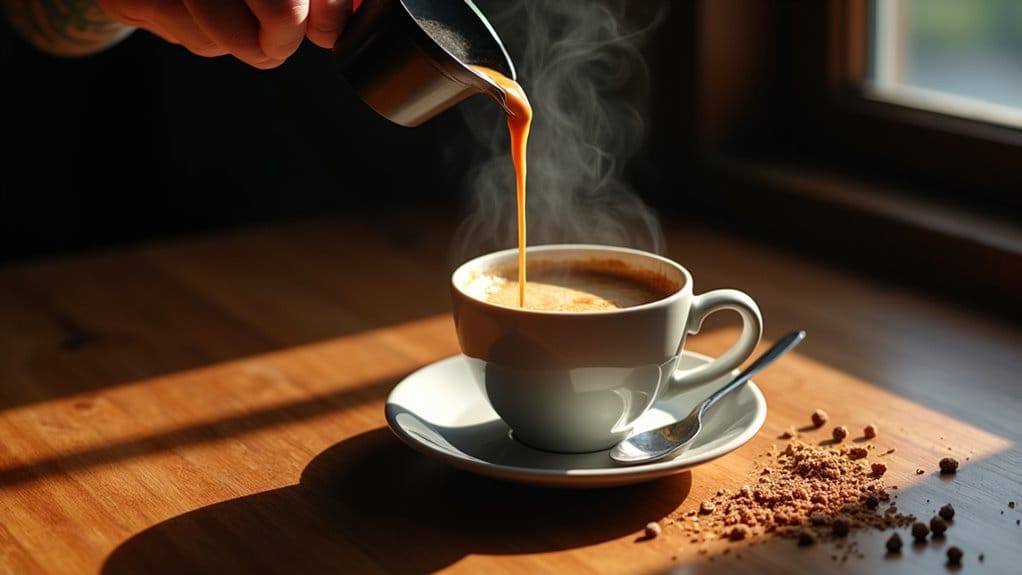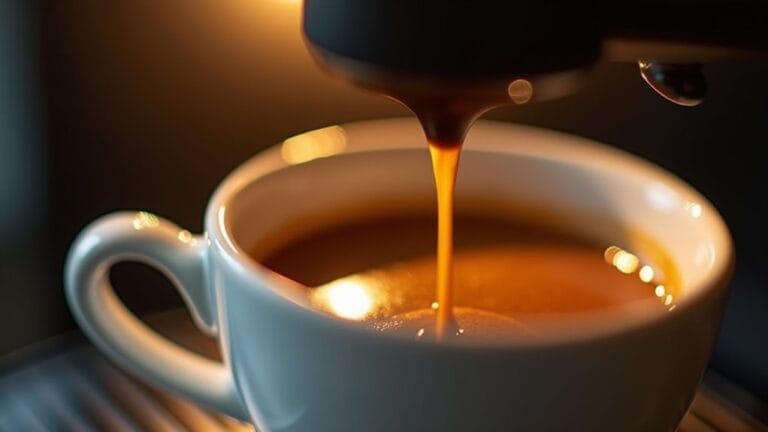What is Cafe Espresso

Café espresso is a tiny but powerful coffee shot made by pushing hot water through very fine grounds with big pressure, giving it a thick body and yummy crema on top!
It isn’t some fancy bean or dark roast, but simply a cool brewing trick that turns regular beans into a tasty, syrupy delight.
Knowing what espresso ain’t—like magic beans or any old coffee—makes you grin because now you see how smart and simple this Italian invention really is. Modern machines standardize high pressure (high pressure) to ensure consistent extraction and flavor.
Definition and Basic Characteristics
A tiny powerhouse of coffee magic, espresso is a super-strong drink made by blasting hot water through very fine grounds with lots of pressure.
People all over the world gulp these little 25-to-30-milliliter shots when they want big flavor fast, no fancy talk needed!
Inside any espresso cafeteria, the barista crushes arabica beans until they’re like dusty cocoa powder, packs them tight, then pulls one shot in about 25 moments flat. That high pressure moment is scientific artistry, making espresso both craft and chemistry in a single burst.
Those flavor and sensory characteristics explode—thick, creamy feel, tiny bubbles called crema on top, plus whispers of chocolate, nuts, even bright fruit, all balanced between gentle sweet and bold bitter.
What Espresso is Not
Confusion melts away when people learn that espresso isn’t just superhero-level coffee, and that tiny “cafe espresso” cup is not some fancy slang for big-drip coffee in disguise!
Café expreso has one core truth: it’s pressure magic, not burnt-bean swill, expresso cafe fans note. Espresso is never a mega-coffee bucket, never a thicker French press, never filtered drip in disguise—no cone, no gravity glug, no five-minute wait! Each mocha contains espresso as a key component, emphasizing the significance of this brewing method for flavor. Beans must be fine-powder snow, not gravel, or the machine spits. Serving thirty-milliliters spells espresso; supersizing it turns it into sad, watery zoombie-java, and nobody cheers for that flavor fail. Espresso brewing conditions affect both flavor and caffeine levels, which is why understanding its unique preparation is essential for aficionados.
How Cafe Espresso is Made
Café espresso happens when super hot water rushes through snug, squashed coffee at nine bars, a squeeze stronger than touching a charging rhino’s back!
You need the espresso box (machine), tiny cup (portafilter), and steady hands to tamp flat, or the coffee sprays like a lawn sprinkler.
Lock, pour, and—boom—thick, tiger-striped crema pops out in 25–35 moments, ready for happy sipping!
High Pressure Brewing Process
When a barista hits the start button, the espresso machine roars to life like a tiny dragon breathing steam, because a powerful pump forces near-boiling water through the coffee puck at around nine times normal air pressure, which is the secret magic behind espresso’s bold taste.
Initially, gentle pre-infusion soaks the grounds, then boom—full 9-bar pressure slams water through, yanking sugars, acids, and yummy oils into your cup.
If the grind is perfect and the puck stays even, every bit of coffee gets the same hot-water hug, giving sweet balance.
Too fine or channeled, and weird bitter spots appear, so pressure spotting matters lots.
Equipment Requirements and Technique
Nine bars of hissing pressure just pulled a tiny, mighty shot—but getting that shot again and again needs more than heat and muscle!
A real cafe locks down three gear heroes: a burly espresso machine (think Linea Classic with shiny levers), a set of precision grinders (one for regular, one for decaf), and tiny helpers like snug tampers, frothing pitchers, and shot glasses spin the magic, plus a knock box and stainless pitchers for happy milk. Additionally, coffee grind size is crucial for optimizing espresso flavor characteristics, ensuring a consistent taste with each brew.
Keep them steady, pound the puck tight, time the pour—boom, heaven in a cup and bright smiles all around! Additionally, investing in premium espresso machines not only enhances the brewing experience but also elevates the quality of the coffee served.
What Makes Cafe Espresso Special

If coffee were a band, espresso would be the lead singer because it belts out flavor with attitude, pouring 75 milligrams of caffeine into every tiny 30-milliliter shot, and that burst of boldness—think chocolate, toasted nuts, and even a cheeky hint of peach—lands on the tongue like fireworks; plus, the golden foam called crema sits on top like a superhero’s shiny helmet, locking all the yummy smells inside until the very initial slurp.
- The high-pressure brew, nine bars squeezing water through teeny grounds, makes it thick and silky, like syrup for grown-ups, which is essential for achieving optimal flavor extraction.
- A shot is done in twenty-five moments flat, way quicker than waiting for drip.
- Crema isn’t just a pretty hat; it holds tiny bubbles bursting with smell, giving espresso its magic aroma and a silky feel that makes the sip super fun!
- This unique brewing process is what makes espresso intensity so cherished among coffee lovers.
Cafe Espresso vs Regular Coffee
Because espresso and regular coffee both start as coffee beans, folks think they’re twins, but they’re more like cousins who dress super different, talk at totally opposite.
| Key Thing | Espresso vs Regular Coffee |
|---|---|
| Brewing Time | 20–30 moments vs 6–12 minutes |
| Texture & Size | 1–2 oz thick velvet shot vs 6–8 oz light liquid hug |
| Flavor Punch | Bold, crema-topped rocket vs wide, mellow sip parade |
When to Choose Cafe Espresso

When does a small, mighty shot of espresso steal the spotlight over regular coffee?
Pop the tiny cup when the brain hits a slow-mo wall, or the legs feel like floppy noodles. It rockets focus in minutes, lifts mood, and beats sugar-filled lattes at the diet game.
- Brain freeze moments – just before exams, big meetings, or deadline panic.
- Gym countdown for instant energy – a superhero punch before workouts.
- Post-lunch slump dodge – kills sleepy vibes faster than a meme loads. Additionally, utilizing the Libbey Gibraltar Cortado Glass enhances the drink’s presentation and aroma, making that espresso experience even more memorable.
Frequently Asked Questions
Can Espresso Shots Expire?
Brief, bitter brews betray brisk breakdown. Espresso shots expire; palatable potency plummets past three days refrigerated, bacterial buildup accelerates, flavor fades fast, freshness forfeits fully beyond forty-eight frigid hours.
Is Espresso Healthier Than Coffee?
Relative health hinges on dosage, roast filtration. Concentrated espresso delivers rapid caffeine plus retained diterpenes; filtered drip yields steadier antioxidants, reduced lipids. Smaller espresso volume lowers gastric load.
Does Espresso Really Wake You Faster?
Scientific data confirm one 30–50 mg espresso shot raises alertness within 15–30 minutes; blood caffeine peaks under an hour, rendering espresso faster-acting than drip coffee for brief, low-dose wakefulness.
Why Does Espresso Taste so Bitter?
Ah, bitter espresso—surely perfection itself. Yet this acrid flaw arises from over-extraction, stale beans, grimy machinery, and scalding water, conspiring to mask nuanced flavour beneath harsh, unrelenting astringency.
Can You Make Espresso Without Machines?
Espresso characteristics emerge from stove-top moka pots, french-press concentration, aeropress pressure, or instant powders; none duplicate authentic crema or nine bar extraction machines provide.
References
- https://en.wikipedia.org/wiki/Espresso
- https://flairespresso.com/learn/espresso-guide/espresso-101/
- https://www.lavazzausa.com/en/recipes-and-coffee-hacks/espresso-definition-vocabulary-curiosities
- https://fixxcoffee.com/blogs/glossary/espresso
- https://www.kitchenaid.com/pinch-of-help/countertop-appliances/coffee-vs-espresso.html





